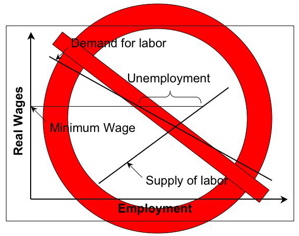The invalid argument behind this position is shown in a simple diagram of the labor market. The x axis is the level of employment. (In other words, the x axis is the flow of labor services.) The y axis is the wage, that is, the price of labor services. We are only interested in the region where both employment and the wage are positive. The supply of labor is typically drawn as an upward-sloping line, showing more people want jobs at a higher wage. The demand for labor from firms is a downward-sloping line. The point of interestion shows the market-clearing wage (on the y axis) and the level of employment when the market clears. A law imposing a minimum wage is represented by a horizontal line above the level of the market-clearing wage. Since labor demand slopes down, this line intersects the demand curve at a level of employment less than the market-clearing level. Furthermore, the horizontal distance along this line between this point of intersection and the point of intersection of this horizontal line with the supply curve shows the level of unemployment ultimately created by the imposition of a minimum wage.
 |
| Figure 1: An Incorrect Model |
Consider firms in a vertially integrated industry producing some quantity of net output. The firms know of various processes for producing commodities in each sector of the industry. Given prices, including wages, they choose the cost-minimizing technique. In a situation of capital-reversing (also known as a positive real Wicksell effect) firms adopt a technique which employs more labor per unit output at a higher wage.
Now this adoption of a more labor-intensive technique might be swamped by the effect on the level of output. But, as far as I know, nobody thinks that the income effect of a higher wage can be relied upon to lead to a decrease in the quantity of final output sold. Nor do I see any reason to think those receiving non-wage income will systematically want to purchase more labor-intensive commodities than the commodities purchased by those receiving primarily wages.
A large literature explains the analysis of the choice of technique. The above explanation of the implications of the arithmetic of cost minimization is one (non-novel) element of some recent papers, for example:
- Anthony Aspromourgos 2001. "Is Labour Cheapening a Means to Reducing Involuntary (Labour) Unemployment?" History of Economics Review, V. 34: 7-18.
- Vienneau, R. L. (2005). "On Labour Demand and Equilibria of the Firm", The Manchester School, V. 73, N. 5 (Sep): 612-619.
- Graham White 2001. "The Poverty of Conventional Economic Wisdom and the Search for Alternative Economic and Social Policies". The Drawing Board: An Australian Review of Public Affairs, V. 2, N. 2 (Nov.): 67-87.
Update: Originally posted 27 April 2006. Updated 9 December 2006 to reflect movement of White URL and inclusion of drawing.


0 comments:
Post a Comment